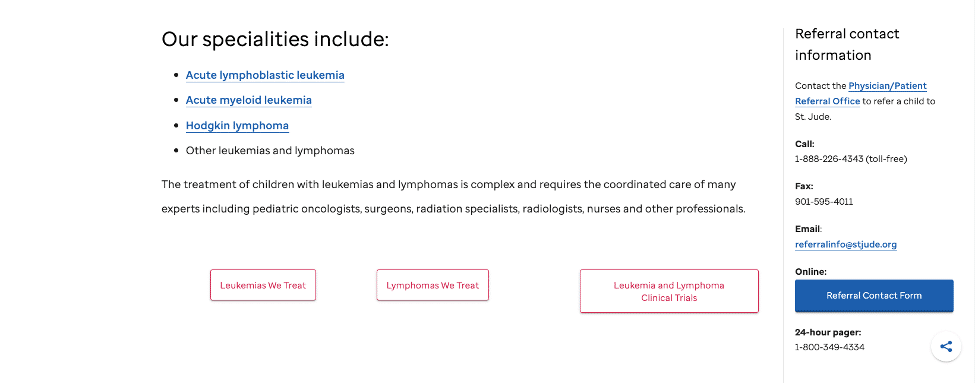Duplicate meta tags, content silos and abandoned blogs, oh my. We’ve been in the healthcare content marketing agency business for quite some time, and we’ve seen hundreds of hospital websites. Many have room for improvement.
We’ve noticed a few themes when it comes to hospital website mistakes. Read about 5 of the most common problems and get tips for how to fix them.
Mistake 1: Poor site navigation
The navigation menu is one of the first things users see when they land on your website. It’s an opportunity for you to answer their pressing questions and quickly get on their good side.
Many hospitals use their navigation menus to show their readers any webpage they deem important. But this can overwhelm users and lead to a high bounce rate.
On top of that, some hospitals align their information architecture to their organization’s structure. They base categories and subcategories on their departments rather than the user journey.
Both of these site navigation issues create a confusing user experience. There’s a reason people say, “When you confuse, you lose.” A confused user heads back to Google, hurting your organic search performance (and your chances of connecting with a new patient).
How to fix it: Organize your navigation menu
Your site’s navigation menu should host the webpages users are looking for. When someone lands on a hospital’s website, they want to know:
- Where is this hospital located?
- How do I make an appointment?
- How can I access the patient portal or pay my bill?
Notice how Penn Medicine designed its navigation menu to answer these patient questions quickly. They highlighted the pages that answer key questions and placed other important pages under relevant subheadings.
Mistake 2: Confusing user journey
One of the golden rules of website content is: Direct your user to a clear next step. Many hospital websites make the mistake of sending users on a dead-end road with no CTA, or they give users too many options.
Remember, when you confuse, you lose. And too many options confuse your readers.
Look at your website and ask:
- Is the navigation menu overflowing with irrelevant links?
- Are there several calls to action above the fold?
- Are you making users “choose their own adventure”?
If so, it’s time to revisit your goals for your website and make changes that will streamline the user journey.
How to fix it: Create a clear path for the user
Fix this hospital website mistake by reorganizing your information architecture.
- Determine which pages belong in the navigation menu and how to present them clearly.
- Organize webpages into category and subcategory “buckets” that align with the user journey.
- Use internal links and CTAs to guide your audience to the desired actions.
Help people find the information they’re looking for on your website and make it easy for them to do what they want to do. Watch this video to see how to improve the user experience on transactional pages like Pay My Bill and Make an Appointment pages.
Pro tip: Want to find the friction points on your site? Your search data can tell you. See which phrases people are searching for most often. This shows you what users are looking for (and having difficulty finding).
Mistake 3: Ineffective messaging
Many healthcare industry websites spotlight their hospital instead of using their content to empathize with patients’ pain points and answer their questions.
Patients land on your website because they have needs. Address those needs in your content … yes, even on your “About Us” page. “Me, me, me” messaging turns readers away.
Another surefire way to lose a reader’s interest is overusing jargon. Research has proven that readers prefer plain language to smart-sounding content. Hospital sites that sound like medical journals can intimidate patients.
How to fix it: Focus your messaging on your patients
Donald Miller, author of Building a StoryBrand: Clarify Your Message So Customers Will Listen, says it best:
“The customer is the hero, not your brand.
When we position our customer as the hero and ourselves as the guide, we will be recognized as a trusted resource to help them overcome their challenges.”
We position our customers as the hero in the story by focusing our messaging on their needs, fears, questions and desires. Use your patients’ words in your messaging and speak to them about what’s important to them.
Wondering how to make sure your messaging resonates with readers? Start by laying the foundation. Create these tools and share them with your content team for consistent, user-centric messaging:
- Patient personas
- Key messaging statements
- Voice and tone guidelines
Mistake 4: Issues with your hospital’s SEO
When it comes to healthcare SEO, minor page-level issues can impact how search engines crawl your pages. One common hospital SEO issue is duplicate or missing metadata.
We often see duplicate headings, like “COVID Update,” on hospital webpages. This subheading makes sense on individual pages, but search engines use H2 tags to understand your content.
In other words, if 500 webpages have “COVID Update” as an H2, search engines will think you have 500 pages about that topic.
Another common hospital website mistake is content silos, when a hospital doesn’t connect related topics through internal links and pillar pages. When content isn’t connected, you aren’t taking advantage of opportunities to lead readers through their customer journey.
How to fix it: Follow healthcare SEO best practices
Understand the 4 types of SEO and optimize for each to solve this medical practice website mistake. You may need to revisit and rewrite metadata. Balance patient-friendly language with SEO-friendly content that shows how your pages are connected.
See how St. Jude uses internal links to direct readers and connect webpages about lymphoma and leukemia:
Additionally, lean into content hubs to improve user experience and SEO. Put everything a user needs to know about a topic in one place for a seamless experience. As a bonus, content hubs prove your authority on a topic to search engines.
Mistake 5: No process for hospital website content maintenance
The greatest mistake you can make with your hospital website is to set it and forget it. Websites are not self-sufficient marketing tools. They require updates and maintenance.
Fresh content makes search engines happy, and current, accurate information earns patients’ trust. Website content needs regular reviews and updates.
We know many healthcare content teams are stretched thin. It’s normal to still be in survival mode after COVID-19. It’s normal to put off webpage rewrites and blog post updates until you have more time as a team.
But unfortunately, we rarely get more time to do what we need to do … and those updates still need to happen. Create and document a content maintenance process to prioritize them.
How to fix it: Create your content maintenance process
Set up your content strategy and processes for your team. Document them for efficiency and consistent implementation. Here are some recommendations to get started:
- Tie your content strategy to your goals as an organization: Every piece of content should work in harmony to achieve your hospital’s goals.
- Map out your content request and approval processes: Who receives requests, and what information needs to be included? What does your workflow look like for editing, approving and publishing content?
- Consider your content distribution workflow: How will you maximize your content’s impact and give it the exposure it needs to perform?
- Define the roles and responsibilities of your team members: Clear expectations set up your team for success and improve collaboration.
See an example content approval workflow that could work for your team:
Looking for more ways to improve your healthcare industry website?
Get the information you need to power up your website and remedy common hospital website mistakes. Subscribe to receive marketing strategy tips exclusively for hospitals and healthcare organizations.
Want to dig deeper? Here are some next-level questions about hospital website best practices:
How can hospitals create more patient-centric content on their websites?
To make your hospital’s website more patient-centric, start by tuning into what your patients are saying. Check out feedback from your surveys and peek into the conversations happening around your services online. Then, shape your content to address those specific concerns and preferences, choosing formats and channels they already engage with and appreciate. Remember to always convey understanding and empathy through your tone, showing patients you’re truly listening.
What are the best practices for keeping hospital website content updated and relevant?
Keep your hospital website fresh and up-to-date by setting a routine for reviewing and updating content. Highlight the latest in care, showcase impactful patient stories, and ensure FAQs reflect the most current inquiries and information.
How can storytelling enhance patient engagement on healthcare websites?
Storytelling enhances engagement by sharing patient success stories and testimonials. These narratives should be authentic and highlight the hospital’s role in supporting patient journeys, making healthcare more relatable.
How can hospitals integrate the latest healthcare trends into website content?
Stay current by weaving the latest healthcare innovations and trends into your website content. Partner with your medical experts to discuss new treatments and technologies, emphasizing how they improve patient care. Keep it relevant to the audience’s needs – you’re not just showing off new equipment.
What strategies can hospitals use to incorporate patient feedback into website content?
Patient feedback is a goldmine for content relevance. Implement it by highlighting common inquiries and topics of interest from patient surveys and social media interactions, and weave these into your content using search-friendly language.





